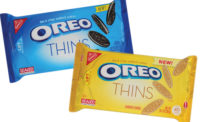State of the Industry 2017: Cookies opt for healthy, better-for-you ingredients
Although indulgent choices still dominate, consumers continue to seek more nutritious options.



courtesy of Otis Spunkmeyer

courtesy of Reading Bakery Systems

courtesy of Ingredion Inc.

courtesy of Reiser

courtesy of Ingredion Inc.

courtesy of Flowers Foods

courtesy of Reiser

Cookies sales

Frozen Cookie Dough sales

Cookie/Brownie Dough sales












When you think about cookies, you might think of them as an indulgence or something high in calories—a treat, to only be eaten on days when you’re not watching your weight. However, in the past year, more better-for-you cookies are hitting the shelves, and there is a wide range of options for consumers.
Overview | Bread | Tortillas | Sweet Goods | Snack Cakes | Pizza | Desserts | Cookies | Buns & Rolls | Bars | Breakfast Products
Market data
Looking at sales date from IRI, Chicago from the 52 weeks ending on March 19, 2017, dollar sales of cookies are up 1.76 percent, accounting for $8.2 billion in sales. Private label saw the most growth, rising 6.29 percent to $1.2 billion. And Campbell Soup Co. brand Pepperidge Farm also performed well, up 5.92 percent to $391.2 million. Mondelez International, with its iconic Nabisco business, still leads the category, but took a slight dip, down 1.15 percent to $3.1 billion.
Top brands from the past year included:
- Nabisco Oreo Thins, up 76.96 percent to $127.0 million
- Nabisco BelVita, up 14.28 percent to $303.2 million
- Nabisco Chips Ahoy, up 2.05 percent to $654.8 million
- Pepperidge Farm Milano, up 9.91 percent to $151.0 million
Oreo Thins were released into the market during summer 2015, and their popularity increased rapidly in 2016. Although classic Oreos were down this year by 7.39 percent, they are still the most-profitable cookie on the market, with $705.8 million in sales.
The frozen cookie dough and refrigerated cookie dough segments both saw sales drops over the past year, while the minor segment of frozen cookies saw some initial growth:
- Refrigerated cookie/brownie dough, down 3.18 percent to $487.5 million
- Frozen cookie dough, down 37.20 percent to $12.2 million
- Frozen cookies, up 3.30 percent to $2.4 million
Annie’s Homegrown, a General Mills brand, made a strong entrance to the refrigerated cookie dough market last summer with its Organic Bake & Share Cookie Dough, offered in Vanilla Sugar, Chocolate Chunk and Oatmeal Raisin. The line saw dollar sales growth of 397.94 percent to $2.7 million. Hampton Creek, famous for its “Just” products, also saw success with its spoonable Just Cookie Dough line, up 487.50 percent to $1.3 million. Hampton Creek bills the product as “Eat-it-raw cookie dough” with front-of-pack messaging, although it’s certainly suited to baking.
Looking back
Different types of cookies have emerged over the past year, with a focus still on better-for-you types, including products with health halos.
“Soft cookies, and the growth of foodservice as a larger channel, have increased dramatically over the past five to 10 years,” says Jim Kappas, vice president, sales and marketing, Malt Products Corp., Saddle Brook, NJ. “In the past 12 months, I would say that non-GMO, organic and clean label have had the most growth.”
There are various types of cookies that can be considered “healthy,” too. “Health-and-wellness cookie options have continued to increase,” says Sam Pallottini, director of cookies, crackers, and pet food, Reading Bakery Systems, Robesonia, PA. “These include gluten-free, caffeinated, low-fat, low-sugar, low-calorie and high-protein options.”
Thin is in, too, as consumers have been reaching for cookies that taste like familiar favorites, but provide a smaller portion size. Within the past year, the cookie category has seen in influx of these types, including:
- Mrs. Thinsters Toasted Coconut Cookie Thins
- Snack Factory Dessert Thins
- Pepperidge Farm Farmhouse Thin & Crispy Cookies
- Mrs. Freshley’s Cake Crisps
- Chips Ahoy! THINS in Oatmeal and Double Chocolate
- Organic Brownie Brittle
- Dancing Deer Crispy Cookie Bites
“Even though snacks and cookies are generally considered indulgent, there is a shift to make indulgent cookies and snacks heathier or better for you,” remarks Ricardo Rodriguez, marketing manager, confectionary and bakery, Ingredion Inc., Bridgewater, NJ.
John McIsaac, vice president, strategic business development, Reiser, Canton, MA, points to more high-protein and energy-style cookies, as recent developments.
Following this trend, in March 2017 Whey 2 Be! released new protein cookies, containing 20 grams of protein, which are also all-natural and non-GMO. Munk Pack protein cookies were also released that month, which offer 18 grams of plant protein. In addition, Munk Pack’s cookies are gluten-free, vegan, non-GMO and kosher.
Looking forward
The right cookie production equipment can significantly streamline operations. “Equipment is about removing labor and creating consistency. Simple, easy-to-use equipment allows customers to produce high-quality products consistently, at lower cost,” says McIsaac. “We like to sell versatility. The same Vemag 500 that can produce a high-inclusion gourmet cookie can also produce a dense energy bar. Our multilane equipment, and high-speed shuttle conveyors, and can deliver multiple formats with quick changeovers.”
Trend-wise, the cookie category continues to flex its appeal, and could drive addition of new equipment. “Frosted or topped cookies are starting to grow in demand. These are cookies that are topped with a frosting-like product. Customers continue to look for unique and tasty treats,” says Pallottini. “Frosted cookies are not only competing against gourmet-style cookies, but also other products such as pastries, cupcakes, muffins, cakes and pies.”
Ingredients are, of course, key to these trends, including those that can be classified as clean label. “The use of non-GMO ingredients has grown in the indulgent category,” remarks Rodriguez. “The use of functional ingredients that can add fiber and protein is also growing.”
Kappas says that customers are looking for familiar ingredients—those found in “grandma’s kitchen”—which are also minimally processed. “Clean label continues to be very important,” he adds.
“We know that consumers are reading labels more than ever, and that if you can provide a cleaner or simpler label, it may be preferred by customers,” comments Rodriguez. “The clean-label movement continues to grow, even in the indulgent category.”
Products with better-for-you ingredients are still hot, and the category looks to become even more popular in 2017. “Demand continues to grow in the segment. The younger generations are looking for quick, healthy snacks that still taste good,” says Pallottini.
“Consumers will continue to look for cookies that can satisfy their cravings and need for an indulgent treat, while also providing added fiber or protein, and that are in the better-for-you category,” says Rodriguez.
Some ingredients can provide multiple benefits to applications like cookies. “The functional and nutritional benefits of malt and oat extracts are greatly underutilized in the industry,” states Kappas. “In addition to reducing oven times and providing a wonderful flavor and aroma, malt extracts have 1.5 times more antioxidants than a half-cup of fresh blueberries.
“Malt extracts, molasses, tapioca, and brown rice syrup all fit the trends,” continues Kappas. “These products are all Non-GMO Project Verified, and are also available in organic varieties.”
Rodriguez recommends pulse ingredients for cookies. “Pulses add the nutritional benefits of protein and help address consumers’ need for protein and fiber-rich, clean-label products. They can boost the nutritional profile of formulations, replace allergens and also help support popular label claims such as ‘non-GMO,’ ‘vegan’ and ‘gluten-free.’” He notes pulse-based ingredients are available as flours or proteins, in peas, lentils, fava beans and chickpea bases.
Fiber is another ingredient that manufacturers could turn to, notes Rodriguez, in order to make a healthier product. “The use of functional ingredients that improve the overall nutritional and better-for-you profile of a product can be extremely desirable,” he says.
Whether consumers choose to indulge or perhaps seek out “better-for-you” options, an increasing diversity of cookie types will continue to be a part of many Americans’ daily snacking routines.
Overview | Bread | Tortillas | Sweet Goods | Snack Cakes | Pizza | Desserts | Cookies | Buns & Rolls | Bars | Breakfast Products
Looking for a reprint of this article?
From high-res PDFs to custom plaques, order your copy today!



















